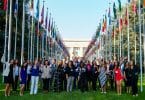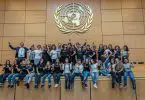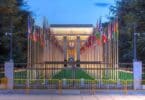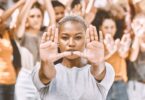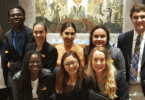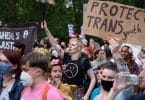International Committee of the Red Cross
The International Committee of the Red Cross (ICRC) is a private international humanitarian organization whose exclusive mission is to ‘’protect the lives and dignity of victims of armed conflict and other situations of violence and to provide them with assistance’’. Established in 1863, the ICRC’s work is based on the Geneva Conventions and the International Red Cross and Red Crescent Movement. The organization prevents suffering by promoting and strengthening humanitarian law.
Wherever the conflicts occur, the ICRC responds quickly to help people who are affected. It does that by meeting immediate material needs and ensuring that consequences of the conflict, such as disease, hunger, loss of income, injury, do not jeopardize the livelihoods of those who are affected. Depending on the nature of the crisis, the ICRC provides help in the material relief (such as medicine, food, cash and similar) as well as repairing water supply plants or building medical facilities. In addition, the organization trains medical and other staff to be able to provide immediate assistance on the field and builds capacities of local institutions to be able to provide essential services such as health care, sanitation and water.
Take a free course on Sustainable Development in Humanitarian Action offered for free by the ICRC.
International Rescue Committee
Founded at the request of Albert Einstein, the International Rescue Committee is an international humanitarian organization that responds to crises and helps people survive and recover. The organization directly helps people and refugees who were forced to flee from war or disaster in five main areas: economic well-being, education, health, empowerment and safety.
The IRC provides cash assistance to people through debit card accounts and where appropriate, with no strings attached. In this way, people can buy what they need themselves, which directly helps the local economies. The IRC also creates quality learning spaces in schools and helps teachers accelerate learning programs for children. When it comes to health, the organization helps people access the health care and empowers community health workers to rightly treat infectious diseases and assist the most vulnerable groups such as children and pregnant women. Ensuring that women, children and marginalized groups have equal access to social and economic opportunities, as well as creating safe non-violent spaces for these groups is at the core of IRC’s activities.
The International Red Cross and Red Crescent Movement
The International Red Cross and Red Crescent Movement is the world’s largest humanitarian network made up of nearly 100 million members, volunteers and supporters in 191 Red Cross and Red Crescent National Societies. The Movement acts as neutral and impartial and its core activity is aiding and protection to people affected by disasters and conflicts. It was founded to protect human life and health, alleviate human suffering and ensure respect for all human beings.
The Movement is composed of three main components: The International Committee of the Red Cross, the International Federation of Red Cross and Red Crescent Societies and 191 member Red Cross and Red Crescent Societies. All three partners in the Movement support communities in conflict and disaster zones to become stronger by implementing a variety of humanitarian activities and development projects. It works with governments, other aid organizations and donors to assist people vulnerable around the world by providing them with an emergency health care, shelter, water supply, sanitation, food and other relief. All components of the movement are independent and each one has its own individual status and exercises no authority over the others.
Oxfam International
Oxfam is a global development organization tasked to mobilize the power of people against poverty. It is an international confederation that consists of 19 organizations that work together with local communities and partners in more than 90 countries. The mission of Oxfam is to change the world of poverty by mobilizing the power of people and working around the globe to find practical and innovative ways for people to be able to do that.
Oxfam directly assists and helps people who are caught up in conflicts and natural disasters around the world by providing them protection, clean water, food and sanitation. The organization conducts active campaigns so that the voices of the poor influence local and global decisions that affect them. Oxfam responds to over 30 emergency situations at any given time by providing life-saving support to those who are the most in need.
Doctors Without Borders / Medecins Sans Frontieres
Doctors Without Borders is a leading international medical relief organization, that implements and manages medical projects in close to 72 countries worldwide. The organization provides direct medical assistance to people affected by armed conflicts, natural disasters, disease epidemics, malnutrition crises and other emergencies. It is focused on emergency medical and humanitarian relief guided by the principles of independence, neutrality and impartiality.
The organization implements medical programs in areas where no health or sanitary systems exist, or where health structures are overwhelmed by the needs of populations. To be able to respond to the most critical needs of patients in field, the organization is committed to providing professional development of its field workers through various types of trainings to build skills and knowledge.
Catholic Relief Services
The Catholic Relief Services (CRS) was founded in 1943 by the Catholic Bishops of the United States to serve victims of the Second World War in Europe. Since then, the organization expanded and presently reaches more than 130 million people in more than 100 countries on five continents. The CRS’s mission is ‘’to assist impoverished and disadvantaged people overseas, working in the spirit of Catholic social teaching to promote sacredness of human life and the dignity of the human person’’. Even though the CRS’s mission is rooted in Catholic beliefs, the organizations works with all people regardless of their race, religion or ethnicity.
The CRS works with local organizations around the globe, as well as with local churches, other organizations and institutions, including governments, foundations, businesses and investors in both disaster and conflict zones. By investing in people and strengthening institutions, organization helps local organizations to develop, increase the impact of joint programming and produce sustainable solutions.
Doctors of the World
Doctors of the World is an international human rights organization that provides emergency and long-term medical care to vulnerable people. It serves more than 1.6 million people every year, through 400 programs in over 80 countries around the world. It provides help to people affected by conflict, refugees and rural communities.
The organization’s staff goes to war zones and the most affected communities that often stay marginalized and invisible to the world. The medical teams all over the world deal with the consequences of wars, natural disasters, and epidemics by taking all necessary measures to support the existing health systems so that they remain open throughout the crisis. In the aftermath of the war or disaster, the organization rebuilds and improves health infrastructure to make a lasting impact in the community.
CARE International
CARE International in one of the largest humanitarian organizations serving 65 million people in over 80 countries around the world to fight poverty and injustice. When there is a humanitarian crisis, CARE is one of the first organizations to arrive and the last to leave. The organization delivers emergency aid to victims of war and natural disasters and helps them rebuild their lives in the aftermath.
During a disaster, CARE coordinates with other organizations and governments to meet immediate needs of victims. Its focus is on four humanitarian sectors: ensuring that people have enough to eat, a roof over their head, clean water and adequate hygiene supplies, and receive assistance for their sexual and reproductive health. The organization also includes women and men in local emergency responses, who work side by side as volunteers by supporting distribution of relief items and helping their communities rebuild their livelihoods.
The Mines Advisory Group
The Mines Advisory Group (MAG) is an international organization that finds and destroys landmines, cluster munitions and unexploded bombs in places affected by conflict. Since its establishment in 1989, the organization has helped over 18 million people in 68 countries to rebuild their livelihoods after war.
After the conflict stops, the battle areas often remain contaminated with unexploded devices. The MAG systematically clears and returns land to local communities for productive use. In addition, the organization recruits and trains men and women from local communities, which gives them an opportunity to clear their communities as well as to financially support their families.
The World Food Programme
The World Food Programme (WFP) was established in 1961 with a goal to provide food aid through the UN system. It became a fully integrated UN programme in 1965 and, today, it is the world’s largest humanitarian agency fighting hunger around the globe.
For more than 50 years, the WFP has provided emergency food assistance in the field to the victims of the war, civil conflict, drought, floods, earthquakes, hurricanes, crop failures and natural disasters. The agency helps communities to improve nutrition and build resilience, as well as their shattered lives and livelihoods. So far, the WFP has managed to assist 80 million people in 80 countries each year.
The United Nations High Commissioner for Refugees
The United Nations High Commissioner for Refugees (UNHCR) is a humanitarian agency that works solely with refugees, returnees, stateless people, the internally displaced and asylum-seekers. The primary goal of the UNHCR is preserve and safeguard the rights of people who have been forced to flee due to war and ensure that everybody has the right to seek asylum and find safe refuge in a third country.
The UNHCR provides emergency assistance on the spot, such as shelter, household items, healthcare, food, clean water and similar. The agency also facilitates the process of sending refugees to third countries or returning them to their home when it is safe. During these situations, the UNHCR provides transportation, assistance and implements income-generating projects. The UNHCR also develop and conducts campaigns to raise public awareness about refugees and the challenges they face.
World Vision International
The World Vision is one of the largest private charities in the world employing around 40.000 staff members working in nearly 100 countries. The organization affects the lives of over 200 million vulnerable children by tackling the root causes of poverty. The organization was founded as a Christian, humanitarian, development and advocacy organization devoted to improving the lives of children and serving all people, regardless of their religion, race, ethnicity, or gender.
During a disaster, such as war, the World Vision staff works hard to make sure children and their families understand how to reduce their vulnerability. Since the end of the Second World War, the World Vision has assisted children in the Korean war, the Western Balkan Wars, Rwandan genocide and Syrian conflict, by working on the ground and responding to their immediate needs, as well as adapting and learning what works best to restore their hopes and belief in the future.
Save the Children
World Vision is an independent organization for children that works in around 120 countries with a vision to live in a world in which every child preserves the right to survival, protection, development and participation. The organization actively works to improve the ways the world treats children and achieve immediate and lasting change in their lives. The organization is guided by several core values: accountability, ambition, collaboration, creativity and integrity.
During the conflict and humanitarian emergencies, the World Vision provides safe spaces for children, so they can feel safe, play and learn. The organization also helps children who have been separated from their families, ensuring that they are taken care through legal systems and reunited with their families. In addition, the organization provides emergency relief and healthcare, psychosocial support, temporary schools and cash grant to families in need.
The Islamic Relief
The Islamic relief is and independent humanitarian organization that has been serving humanity for almost 35 years. The organization is currently present in over 40 countries across the world striving to help almost three billion people still living in poverty. The organization is inspired by the Islamic faith and values and believes that people who are wealthy have a duty to help those who are less fortunate regardless of race, political affiliation, gender or religious belief.
The projects that the organization implements, provide poor people with access to vital services. The Islamic Relief protects communities from disasters and delivers life-saving emergency aid. The organization helps victims of war directly by delivering food, clothes and other essential kits through its offices on the field and warehouses. In conflict settings, the organization also rebuilds houses and public building like schools. Last but not least, the organization also provides an interest-free loans system to support unemployed people in the post-conflict settings.
INTERSOS
INTERSOS is a humanitarian organization that works around the world providing assistance to victims or armed conflicts and natural disasters. The organization intervenes to meet the needs of people in crisis, while giving special attention to vulnerable groups such as women and children, ensuring that their basic needs are met. Presently, the organization works in 16 countries around the world.
The INTERSOS intervenes in the shortest time possible when a war or natural disaster occurs, distributing basic goods for survival, such as food, seeds and agricultural tools for food sustainability. During a crisis situation, the organization is also active in promoting the right to education by building or rebuilding schools and training teachers. In addition, the organization provides access to medical services by supporting local healthcare systems as well as ensuring access to clean water and sanitation.
International Medical Corps
The International Medical Corps is a global non-profit humanitarian organization dedicated to saving lives by providing emergency medical services, healthcare trainings and development programs to those in need. The organization works on the front lines delivering emergency healthcare to victims of war and natural disasters, no matter where they are and what the conditions are.
Currently, the International Medical Corps staff works in the most urgent crisis, such as the Syrian conflict, where a civil war has displaced millions of people, who have found refuge in neighboring countries and beyond. The teams are delivering medical relief on the spot as well as training and working with local healthcare staff to become effective first responders themselves.
Norwegian Refugee Council
The Norwegian Refugee Council (NRC) is an independent humanitarian organization that helps people forced to flee. Currently, the organization works in 31 countries, where its helps save lives and rebuild futures.
The core activities of the organization are camp management, food assistance, clean water, shelter, legal aid and education. In addition, the NRC advocates for displaced people and defends their rights in local communities, with national governments and in the international arena. Currently, around 14.000 humanitarians work with the NRC and majority directly in the field.
The UN Relief and Work Agency for Palestine Refugees in the Near East
The UN Relief and Work Agency for Palestine Refugees in the Near East (UNRWA) was established in 1949, to carry out direct relief and programmes for Palestine refugees. When the Agency began working in 1950, it was responding to the need of about 750.000 Palestine refugees. Today, around five million Palestine refugees receive the UNRWA services.
The humanitarian services that are carried out by the UNRWA encompass primary and vocational training, primary health care, relief and social services, infrastructure and camp improvement, microfinance and emergency response during an armed conflict. The Agency recognized education being fundamental in helping children achieve their full potential. Therefore, the UNRWA has been successful in operating 711 elementary schools and providing free basic education for 526.000 Palestine refugee children.
Action Aid
Action Aid is an international organization that supports people living in poverty and exclusion. The organization works closely with civil society organizations and social movements to deliver emergency relief, implement grassroot projects and campaign for causes such as women’s economic justice, tax justice and climate justice. The organizations work covers four areas: women, politics and economics, land and climate, and emergencies. A particular focus is put on women’s rights in all areas of Action Aid’s work.
During wars and other disasters, Action Aid helps women who human rights are likely to be endangered or violated. In addition, when it comes to humanitarian response women and women’s organizations are significantly underrepresented in humanitarian responses. For this reason, the Action Aid supports and empowers women in such settings to become active players and leaders.
The Adventist Development and Relief Agency International
The Adventist Development and Relief Agency (ADRA) is the global humanitarian organization of the Seventh-day Adventist Church. ADRA delivers relief and development assistance to affected people in more than 130 countries regardless of their ethnicity, political affiliation or religious beliefs. ADRA improves quality of life of millions of people through nine impact areas: livelihoods and agriculture, children, water, sanitation and hygiene, community health, disaster response, economic growth, hunger and nutrition, social justice and gender equity.
Besides responding to natural disasters, the ADRA is also present in conflict areas where it directly helps and supports the victims of war by providing them with essentials. The organization is mostly active in refugee camps helping victims who were forced to flee by providing them with clean water, food, sleeping mats and blankets and clothes.
Refugees International
Refugees International is humanitarian and independent organization that provides support and advocates for displaced people, including refugees, internally displaced and stateless people. The organization does not accept any type of UN or government funding. One of the core activities of the organization is publishing longer reports, including approximately twenty-five field reports throughout the year on displacement accompanied with comments on international aid and issues concerning girls and women.
When it comes to armed conflict, the organization puts a lot of emphasis on helping girls and women as vulnerable category that find themselves in exceptional danger of living with the constant threat of gender-based violence, such as rape, sexual assault, domestic violence and similar. Therefore, the organization prioritizes advocating for improved humanitarian responses that support the safety and well-being of women and girls.
The Alliance for International Medical Action
The Alliance for International Medical Action (ALIMA) was established in 2009 as an international humanitarian organization that brings together aid workers, national medical organizations and global research institutions to provide quality medical care to people in need and conduct research to improve humanitarian medicine. So far, ALIMA has treated more than two million patients, conducted 56 programs in 13 countries. It also launched ten research projects that focus on malnutrition, malaria, Ebola, and surgery.
ALIMA works with local and national organizations to provide medical care to people affected by armed conflicts, displaced people, people affected by epidemics and emerging illnesses. By sharing local knowledge, ALIMA gains a deeper understanding of the contexts in which it works, and it can prioritize the medical research.
SOS Children Villages International
The SOS Children’s Villages International is composed of the Federation of 118 SOS Children Villages Associations. As members of the Federation, each SOS Children Village is dedicated to applying the standards of child care in accordance with the Federation statutes.
In situations of war and violence, the SOS Children Villages launches an emergency response programmes for children and families who need urgent assistance. The emergency response teams of the organization have helped children at risk in more than 160 humanitarian situations around the world. The organization specializes in protection and care of children, such as care for unaccompanied and separated children, family reunification, child friendly spaces and psychological and social support. The organization also supports families with health, food, shelter and similar, to prevent their separation.
Lutheran World Relief
The Lutheran World Relief was established by Lutherans in the United States after the Second World War with a mission to tackle global poverty by helping people to adapt to challenges that threaten their livelihoods. The organization works with all people, regardless of their race, nationality or religion.
During an emergency, such as breakout of civil war, the organization helps families to restore their lives by providing them with aid and partnering up with local communities to build and grow rural economies. The ultimate goal of the organization is to help people build self-sufficiency and create new solutions to break the cycles of poverty.
War Child
The War Child was founded in 1993 by movie makers David Wilson and Bill Leeson, after their visit to the former Yugoslavia and witnessing of ethnic cleaning and violence and its impact on children. Thus, the organization was formed to work with children, families, communities, legal services and local authorities before, during and after armed conflicts, to develop and strengthen child protection systems.
The activities of the organization include rehabilitation of former child soldiers, improving justice for children, setting up child helplines and protection networks, as well as reunifying children with their families. One of the central activities of the War Child is protection of children’s right to education to help them to keep a sense of normality and improve prospects of long-term recovery.


